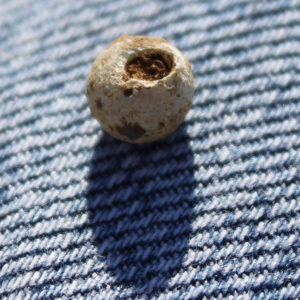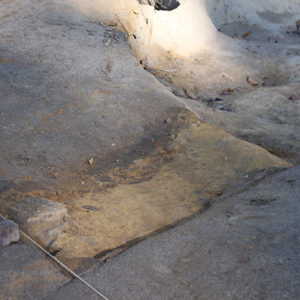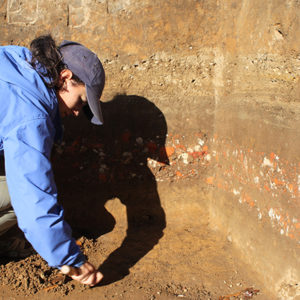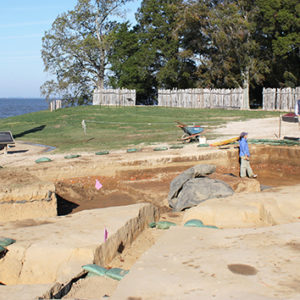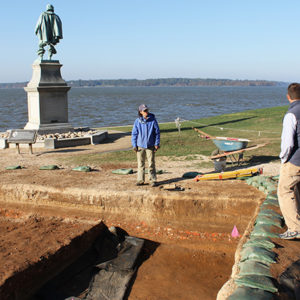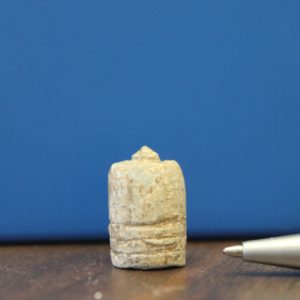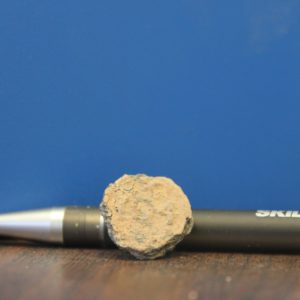Another posthole from James Fort’s 1608 church has surfaced at the northernmost extent of the church excavation area. This new posthole is 12 feet from the previous one, continuing a spatial pattern established by the other postholes. A total of eight postholes have now been found. In the excavation area to the north, archaeologists are searching for evidence of a cobblestone foundation in two conjoining wall soil stains. The soil used in the foundation trenches is of a different type than the surrounding earth and appears similar to the type used in two nearby buildings dating to the 1610s. Among the artifacts are a jacket button from a German soldier who fought in the Battle of Yorktown in 1781 and a Civil War Minié Ball carved into a chess piece.
Another posthole from the 1608 church has been found right where it should be, 12 feet away from the last one in the structure’s northern wall. William Strachey, secretary of the colony, recorded the dimensions of the church as 60 feet long and 24 feet wide. So far, postholes have been turning up at neat 12-foot intervals. The southeast of the two shorter ends consists of three postholes 12 feet apart, matching Strachey’s 24 feet description. Neither of the two longer walls nor the shorter northwest wall has been fully discovered yet, but several postholes from the longer walls have been excavated and they are turning up at 12-foot intervals as was the case with the latest one. If the archaeologists’ theory that this building is the fort’s first substantial church holds true, then the 12-foot spacing makes sense because five 12-foot wall sections would equal 60 feet, matching Strachey’s description.
Archaeologists are excavating this latest posthole, the eighth to be found, trying to find the exact bounds of the feature before mapping its location. Artifacts have been scarce in the church layers but this is typical for such an early feature.
Above the church posthole layers lies a layer of brick rubble that probably once belonged to Jamestown’s 18th-century church which stood adjacent to the 17th-century church tower still standing today. One theory regarding the rubble is that the APVA’s early archaeologists (ca. 1900) removed much of the 18th-century church’s rubble from its original location to where it lies now in order to gain access to and excavate the earlier 17th-century church layers underneath.
During the excavation of these newer layers, the Jamestown Rediscovery archaeologists have found a couple of very interesting artifacts that, while not from the fort period, shed light on Jamestown Island’s role during other tumultuous times in our nation’s history. A copper-alloy button bearing the number 104 belonged to a member of the Zweibrücken Regiment, a unit raised in the German Duchy of the same name. Serving with the French as part of an alliance established in the 1750s, the Regiment Royal Deux-Ponts (as they were known in the French Army) played a pivotal role in the Battle of Yorktown in 1781.
In conjunction with French units, the Zweibrücken Regiment successfully stormed and drove the British from Redoubt 9, an enclosed fort outside the main British defenses at Yorktown. A few companies of the regiment were stationed at Jamestown after the victory at Yorktown and this may have been when the button was lost.
Another war-related artifact, dating to eighty years later, and also found in the soil above the church posthole layers is a Minié Ball fashioned into a chess piece. The Minié Ball, a conical bullet with grooves running around its base, was widely used by both Union and Confederate forces. Upon being fired, the heated gases from the igniting gunpowder behind the bullet deformed and expanded it so that its grooves caught the rifling inside the gun’s barrel. As the bullet moved forward, it began to spin due to the groove/rifling interaction. The spin made the Minié Ball significantly more accurate and gave it much greater range than conventional musket balls. Its invention should have made the centuries-old tactic of sending lines of men to fire at each other from yards apart obsolete, but this was the first war in which the Minié Ball saw widespread use. Those in command were trained in and had fought in previous wars using Napoleonic-era tactics, in part guided by the short range and inaccuracy of musket balls. Thus the soldiers lined up as their predecessors had, and the carnage was unlike any the world had seen.
This particular Minié Ball retains its grooves at the base, but the top cone portion has largely been cut away to transform the bullet into a chess piece. Civil War soldiers spent far more time in camp than they did fighting battles, and creating diversions such as homemade chess sets was not uncommon.
Several yards to the north of the church site, excavations continue on some possible fort-period structures. Two conjoining wall soil stains are being excavated for signs that they once contained cobbles as part of the foundation for a structure. The soil comprising the stains is remarkable in that it is a different type of soil than the immediate surroundings and it matches the soil type used in the cobblestone foundations of two nearby buildings dating to ca. 1611. One possible reason for the use of this particular type of soil is that it was of a particular malleability that would allow the cobbles’ height to be adjusted for a level foundation. Cobbles were found in the two nearby buildings’ foundations, but none exist at the building that is currently being excavated. Archaeologists are searching for any signs that they were there at one time.
The circular feature filled with iron slag, ash, and other byproducts of iron making may not be the site of the actual furnace as was thought last month. Archaeologists have excavated a portion of the feature, creating a cross-section of it. Upon reaching the soil beneath the ashy layers, they were surprised to discover that the tell-tale evidence of exposure to extreme heat is missing. During the excavations of other heat-related features such as ovens, archaeologists have observed that the soil in the immediate vicinity turned a reddish color and became especially hard, essentially becoming brick. There are no such transformations of the soil here and so the iron-making furnace was probably elsewhere. This feature may have just been a pit for dumping some of the unwanted scrap from an iron-making operation.
In the lab, curators, conservators and volunteers are processing the huge numbers of artifacts that came out of the fort’s first well (1608), excavated last year. Faunal remains from the feature number in the thousands and they’re currently being sorted and cataloged. Among the remains being processed are turtle shell fragments, vertebrae from fish, dolphins, and land mammals, fish scales, ribs from fish and small mammals, rodent teeth, crab claws, and fowl esophagus bones. Conservator Dan Gamble is using the air abrasion machine to remove rust from an iron powder flask also found in the 1608 well. Another piece of iron is fused to the tip of the flask due to rust accretions. Powder flasks were used to hold and dispense gunpowder when needed by musketeers.
related images
- A gooseberry bead found in the fill above the 1608 church
- A partially-excavated section of the wall stain. Note the different color of its earth compared to the surrounding soil.
- Archaeologist Danny Schmidt answers questions for a school tour group.
- Archaeologist Mary Anna Richardson searches for the bounds of the latest church posthole.
- Conservator Dan Gamble uses air abrasion to remove corrosion from a gunpowder flask found in the 1608 well.
- Faunal remains from the 1608 well,
- The 1608 church dig site
- The ashy feature has been partially excavated to create a cross section.
- The church excavation site. The brick rubble layer can clearly be seen.
- The outline of a burial inside the 1608 church walls
- The Minié Ball chess piece
- A copper-alloy button belonging to the Zweibrücken Regiment. Note the ‘104’ on its face.



